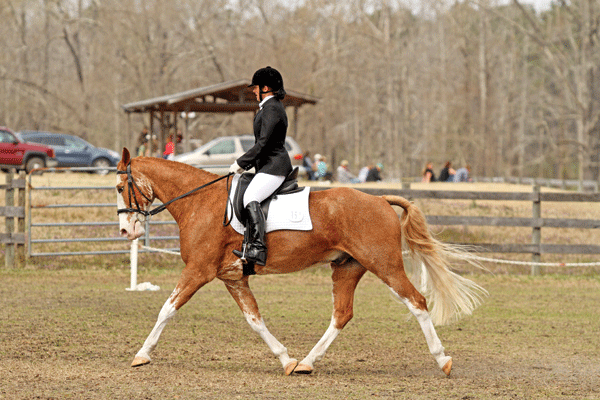
In this photo, Briana Timmerman is riding her horse, A Splash of Henry, in a Novice eventing test. Henry is trotting with an active hind leg and good forward impulsion—what looks like a nice frame for a Novice test. He appears focused and concentrating on his rider.
This is an interesting photo because, even though the outlines of the horse and rider are quite nice and correct, the picture does lack some feeling of suppleness and lightness. Henry is active and carrying his tail freely, his neck is the highest point and his nose line appears vertical. Briana sits upright and her seat is pretty close to the classical lines (ear–shoulder–hip–heel and elbow–hand–horse’s mouth), but still there is visible tension.
When observing the contact more closely, I see that Henry does work in the correct position, but in this moment his mouth is a bit dry and he appears to be slightly tense in his jaw. This gives the impression that he is a little strong in the contact. Briana is holding her hands in the correct line, but it looks as if in the next movement she will be taking more contact. She appears to be getting pulled very slightly out of a deep seat, with her shoulders coming forward and her seat bones pointing backward.
In this moment the horse does not appear to be in front of Briana’s forward driving aids. Instead, he appears to have his own forward drive and Briana is busy controlling him. As she is not pulling back or holding stronger than Henry’s power is working from behind, the outline of their performance is correct. I would encourage Briana to sit a little deeper, connect more with her seat and control Henry’s energy more with her body than with her hands. Even a forward-going horse needs forward driving aids to improve his balance.
Try this: Stand in front of a wall with slightly bent knees (as you would in riding position) while holding your arms as if you were holding reins so that you can touch the wall with your knuckles. Now push very gently against the wall, starting with the bottom of your hand (pinky finger first) and feel what is happening in your body.
You should feel your shoulders move down, your abdominal muscles become active (stable core!) and your weight shift down your back toward your heels. This forward push of the hands is similar to the giving and yielding of the hands at the end of every half halt. This shows that the motion of giiving is followed by sitting deeper, with more core stability and a longer leg position.
Imagining that there is an invisible wall in front of your hands as you ride also can help you learn how to give and sit with a stable core to control the horse with your seat.
I am sure that this image can help Briana to connect more with her horse and turn his forward energy into more balance and lightness, which will improve their partnership and harmony.
Susanne von Dietze is a leader in equestrian biomechanics. A physiotherapist, licensed Trainer A instructor and judge for dressage and show jumping, she gives lectures and seminars throughout the world, including at the prestigious German Riding Academy in Warendorf. She is a native of Germany and now lives with her husband and three children in Israel, where she competes at the international level. She is the author of two books on the biomechanics of riding: Balance in Movement and Horse and Rider, Back to Back. Find her books at HorseBooksEtc.com.
You can submit your high-resolution dressage photo for critique (300 dpi and 4 by 6 inches in size). Or you can send your photo with a link to a short video. Email to DressageToday@AimMedia.com. Turnout in dressage show or clinic-appropriate attire is encouraged. Don’t forget your helmet!











